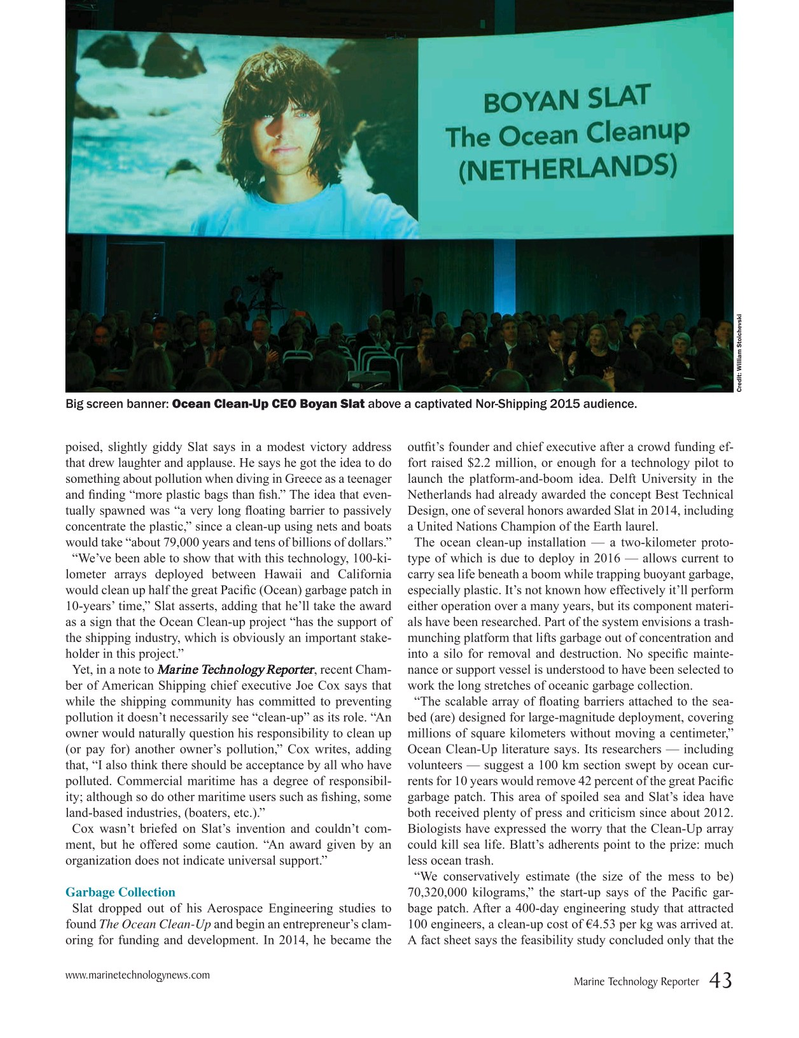
Page 43: of Marine Technology Magazine (October 2015)
AUV Operations
Read this page in Pdf, Flash or Html5 edition of October 2015 Marine Technology Magazine
Credit: William Stoichevski
Big screen banner: Ocean Clean-Up CEO Boyan Slat above a captivated Nor-Shipping 2015 audience.
poised, slightly giddy Slat says in a modest victory address out? t’s founder and chief executive after a crowd funding ef- that drew laughter and applause. He says he got the idea to do fort raised $2.2 million, or enough for a technology pilot to something about pollution when diving in Greece as a teenager launch the platform-and-boom idea. Delft University in the and ? nding “more plastic bags than ? sh.” The idea that even- Netherlands had already awarded the concept Best Technical tually spawned was “a very long ? oating barrier to passively Design, one of several honors awarded Slat in 2014, including concentrate the plastic,” since a clean-up using nets and boats a United Nations Champion of the Earth laurel.
would take “about 79,000 years and tens of billions of dollars.” The ocean clean-up installation — a two-kilometer proto- “We’ve been able to show that with this technology, 100-ki- type of which is due to deploy in 2016 — allows current to lometer arrays deployed between Hawaii and California carry sea life beneath a boom while trapping buoyant garbage, would clean up half the great Paci? c (Ocean) garbage patch in especially plastic. It’s not known how effectively it’ll perform 10-years’ time,” Slat asserts, adding that he’ll take the award either operation over a many years, but its component materi- as a sign that the Ocean Clean-up project “has the support of als have been researched. Part of the system envisions a trash- the shipping industry, which is obviously an important stake- munching platform that lifts garbage out of concentration and holder in this project.” into a silo for removal and destruction. No speci? c mainte-
Yet, in a note to Marine Technology Reporter, recent Cham- nance or support vessel is understood to have been selected to ber of American Shipping chief executive Joe Cox says that work the long stretches of oceanic garbage collection.
while the shipping community has committed to preventing “The scalable array of ? oating barriers attached to the sea- pollution it doesn’t necessarily see “clean-up” as its role. “An bed (are) designed for large-magnitude deployment, covering owner would naturally question his responsibility to clean up millions of square kilometers without moving a centimeter,” (or pay for) another owner’s pollution,” Cox writes, adding Ocean Clean-Up literature says. Its researchers — including that, “I also think there should be acceptance by all who have volunteers — suggest a 100 km section swept by ocean cur- polluted. Commercial maritime has a degree of responsibil- rents for 10 years would remove 42 percent of the great Paci? c ity; although so do other maritime users such as ? shing, some garbage patch. This area of spoiled sea and Slat’s idea have land-based industries, (boaters, etc.).” both received plenty of press and criticism since about 2012.
Cox wasn’t briefed on Slat’s invention and couldn’t com- Biologists have expressed the worry that the Clean-Up array ment, but he offered some caution. “An award given by an could kill sea life. Blatt’s adherents point to the prize: much organization does not indicate universal support.” less ocean trash.
“We conservatively estimate (the size of the mess to be)
Garbage Collection 70,320,000 kilograms,” the start-up says of the Paci? c gar-
Slat dropped out of his Aerospace Engineering studies to bage patch. After a 400-day engineering study that attracted found The Ocean Clean-Up and begin an entrepreneur’s clam- 100 engineers, a clean-up cost of €4.53 per kg was arrived at. oring for funding and development. In 2014, he became the A fact sheet says the feasibility study concluded only that the www.marinetechnologynews.com
Marine Technology Reporter 43
MTR #8 (34-49).indd 43 9/29/2015 2:54:59 PM

 42
42

 44
44
